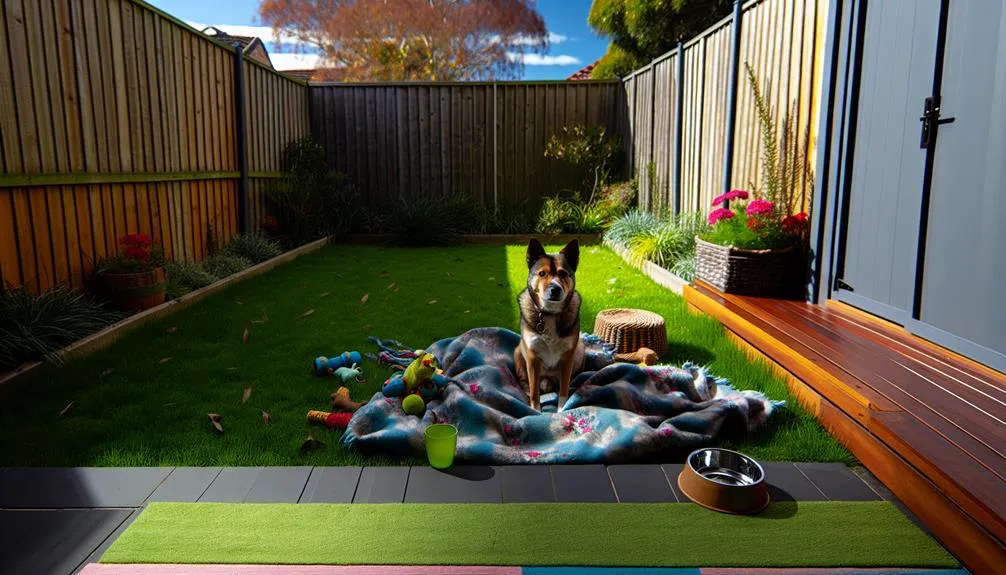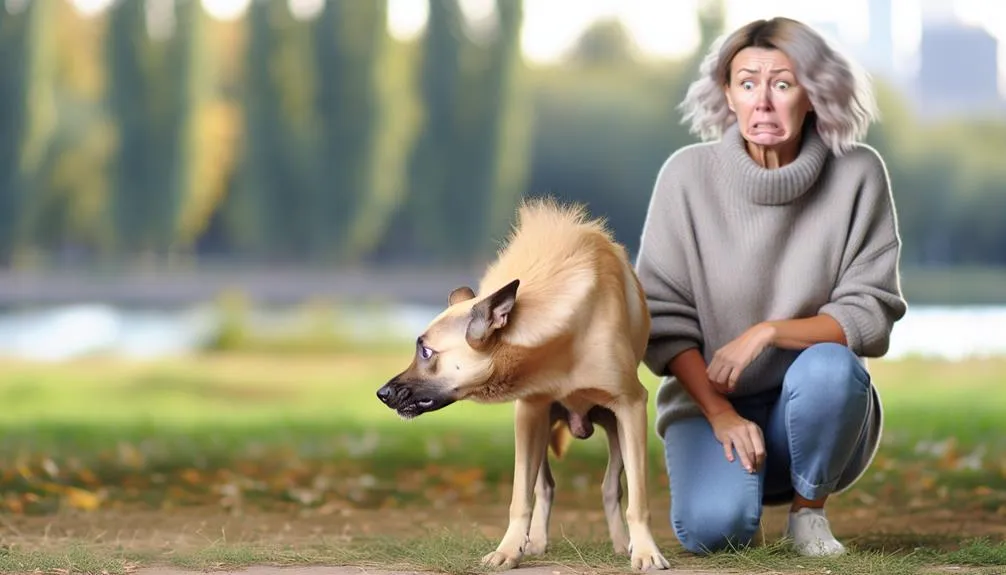
How to Watch a Dog You Dont Know Very Well
Imagine you're at a friend's house, and they ask you to watch their dog, Max, who you've met only once. It's essential to understand how to interact with a dog you don't know very well, as each one has its own unique personality and needs. By observing Max's body language and behavior, you can start to gauge his comfort level and how to approach him. But what specific signs should you look for to guarantee a safe and positive experience for both of you? Let's explore the key strategies that can help you navigate this situation effectively.
Assessing the Dog's Behavior
When you're watching a dog, it's crucial to pay close attention to its behavior, as this can reveal a lot about its mood and needs. Each dog has unique personality traits that shape how it interacts with the world. For instance, a dog that's confident might approach you boldly, while a shy dog may hang back and observe from a distance. Recognizing these differences can help you understand the dog better.
Canine communication styles are another critical aspect to evaluate. Dogs communicate through a combination of vocalizations, body movements, and facial expressions. A wagging tail often signals happiness, but the speed and position can indicate different feelings. For instance, a slow wag might suggest uncertainty, while a high-speed wag signifies excitement.
It's also important to be aware of how a dog responds to various stimuli. If a dog seems tense or avoids eye contact, it may feel stressed or threatened. On the other hand, a relaxed posture and soft eyes typically indicate comfort and trust.
Understanding Body Language
To truly connect with a dog, you need to pay attention to its body language. Relaxed postures, like a wagging tail or a loose stance, indicate comfort and happiness, while signs of stress, such as tucked tails or pinned ears, can signal anxiety. By recognizing these cues, you can better understand what your furry friend is feeling and respond appropriately.
Recognizing Relaxed Postures
There's something reassuring about a dog that's completely at ease, and recognizing those relaxed postures can deepen your bond with your furry friend. When a dog shows a relaxed demeanor, it's a sign of comfort and trust. Here are three calm signals to look for:
- Loose Body: A dog with a relaxed posture will have a loose body, not tense or rigid. Their legs will be slightly bent, and their tail may rest low or wag gently.
- Soft Eyes: When dogs are relaxed, their eyes appear soft and may even squint slightly. They won't be staring intensely, which can indicate stress.
- Playful Behavior: A dog that's comfortable might playfully bow, with their front legs stretched forward and their rear in the air, inviting you to join in the fun.
Identifying Signs of Stress
Identifying signs of stress in a dog is essential for ensuring their well-being and comfort. When you're observing a dog you don't know well, it's vital to pay attention to their body language. Stress signals can manifest in various ways, and recognizing these behavioral cues can help you respond appropriately.
Watch for changes in posture; a dog that's stressed may cower or tuck their tail between their legs. Ears pinned back and a tense body are also strong indicators of discomfort. You might notice the dog yawning excessively, licking their lips, or panting—not just due to heat. These behaviors often reflect anxiety rather than physical needs.
Additionally, keep an eye on their eyes. Averted gaze or wide-open eyes can signal stress. If the dog is whining or barking more than usual, it's a sign they're feeling overwhelmed.
Creating a Safe Environment

Creating a safe environment for your dog is essential for their well-being and happiness. When you're watching a dog you don't know very well, making sure their surroundings are secure can make all the difference. Here are three important steps to take into account:
- Dog Proofing Space: Before the dog arrives, take the time to remove any hazardous items. This includes medications, cleaning supplies, and small objects that could be swallowed. Check for electrical cords and make certain they're out of reach.
- Establish Safe Zones: Create designated areas where the dog can retreat if they feel overwhelmed. This could be a cozy bed or a quiet corner in a room. Make sure these safe zones are free from disturbances and allow the dog to relax.
- Supervised Exploration: When the dog is exploring your space, keep a watchful eye. Observe how they interact with their environment and be ready to intervene if they show interest in something unsafe.
Approaching the Dog
Approaching a dog, especially one you're unfamiliar with, requires a gentle touch and keen observation. Before you take any steps toward the dog, watch its body language carefully. Is the dog relaxed and wagging its tail, or does it seem stiff and tense? Understanding these signals can help you gauge the dog's mood and readiness for a dog introduction.
When you feel it's appropriate to approach, do so slowly and calmly. Avoid sudden movements that might startle the dog. Instead of walking straight toward it, angle your body to the side, presenting a less confrontational posture. As you get closer, offer friendly greetings in a soft voice. This can help the dog feel more at ease with your presence.
It's best to let the dog come to you, rather than rushing in. Extend your hand slowly, palm facing down, and allow the dog to sniff you if it chooses. This is an essential part of the dog introduction process, as it allows the dog to gather information about you in a non-threatening way. If the dog seems interested and comfortable, you can gently stroke its back or side.
Establishing Trust and Comfort

To establish trust and comfort with a dog, it is crucial to pay close attention to their body language. Using slow interaction techniques can help you gauge their comfort level, while positive reinforcement methods will encourage a bond between you. By being observant and patient, you'll create a safe environment for the dog to feel secure.
Body Language Awareness
Understanding a dog's body language is essential for building trust and comfort between you and your furry friend. Recognizing their signals can help you respond appropriately to their needs and emotions. Here are three key aspects to observe:
- Tail Position: A wagging tail can indicate excitement, but the speed and height matter. A low wag might signal uncertainty, while a stiff, upright tail can show confidence or aggression.
- Ear Position: Ears that are perked up and facing forward show alertness. Conversely, ears pulled back might indicate fear or submission.
- Body Posture: A relaxed body, with a slightly open mouth, generally denotes a happy dog. Tensed muscles or a lowered body can signal stress or discomfort.
Slow Interaction Techniques
When it comes to building trust with your dog, slow interactions can make all the difference. Dogs are sensitive creatures, and they often need time to acclimate to new people and environments. By adopting a calm presence, you can help ease any anxiety the dog might feel. Start by simply sitting quietly nearby, allowing the dog to observe you without feeling pressured.
Once the dog seems comfortable, use a gentle approach to engage. Avoid sudden movements or loud noises, as these can startle them. Instead, slowly extend your hand, palm up, and let them come to you at their own pace. This respects their boundaries and helps them feel safe.
If they show interest, you can gradually introduce soft vocalizations or gentle gestures. Speak softly and stay relaxed; your demeanor can greatly influence their comfort level. Remember, patience is key. If the dog seems hesitant, take a step back and allow them more time to adjust. Each dog is unique, so adapt your interactions based on their reactions. Establishing trust isn't rushed; it's a gradual process that lays the foundation for a rewarding relationship.
Positive Reinforcement Methods
Positive reinforcement is a powerful tool for establishing trust and comfort with your dog. By using positive reinforcement methods, you can create a bond that encourages good behavior and eases their anxiety. Here are three effective strategies to contemplate:
- Clicker Training: This method involves using a clicker to mark the exact moment your dog performs a desired behavior. Pair the click with a treat for immediate rewards, reinforcing their actions.
- Reward Systems: Develop a consistent reward system that includes treats, praise, or toys. This helps your dog understand what behaviors are encouraged and builds their confidence.
- Patience and Consistency: Always be patient and consistent with your approach. Repeating commands and rewards helps your dog learn and feel secure in their environment.
When you focus on these techniques, you'll notice improvements in your dog's comfort level and responsiveness. Creating a positive atmosphere will not only help your dog feel safe but will also foster a deeper trust between you both. Remember, building this bond takes time, but the rewards are well worth the effort.
Engaging in Playtime Activities
Engaging in playtime activities is one of the most enjoyable ways to bond with your dog while keeping them mentally and physically stimulated. When you're spending time with a dog you don't know very well, observing their reactions during play can help you gauge their personality and preferences. Start with simple fetch games; they're a classic way to engage a dog and can be tailored to fit their energy levels. If the dog seems hesitant, toss the ball a shorter distance at first to build their confidence.
Interactive toys can also be a great addition to your playtime routine. These toys often require the dog to think and problem-solve, keeping their minds sharp while providing entertainment. Look for toys that dispense treats or have hidden compartments, as these can captivate a dog's attention and motivate them to explore and play.
While playing, pay attention to the dog's body language. Are they wagging their tail? Do they seem excited? If so, you're likely on the right track. Conversely, if they appear disinterested or anxious, it might be best to switch activities or give them a little space. Remember, every dog is unique, and their play preferences can vary widely. By engaging in fetch games and using interactive toys, you'll not only help keep the dog active but also foster a trusting relationship. Enjoy this time; it's a wonderful opportunity to connect with your furry friend!
Knowing When to Seek Help

Knowing how to read a dog's body language during play can be a helpful skill, but there may come a time when you notice signs that indicate a dog needs more than just a fun activity. It's crucial to recognize when the situation might require professional intervention. Here are three signs to watch for:
- Excessive Aggression or Fear: If the dog shows signs of aggression toward people or other dogs or seems overly fearful, it's time to seek help from behavior specialists or local trainers.
- Injury or Illness: If you notice any physical injuries or signs of distress, such as limping or unusual whining, contact a veterinarian immediately for support.
- Lack of Owner Communication: If the owner seems unclear about the dog's needs or hasn't provided safety protocols, make sure you have emergency contacts ready to guarantee the dog's safety.
If you find yourself in one of these situations, don't hesitate to reach out for professional advice. Training resources, like local trainers or behavior specialists, can offer insights tailored to the dog's specific needs. Familiarize yourself with first aid for pets, just in case. Always keep veterinary support numbers handy. Remember, it's better to err on the side of caution, especially in dog safe spaces where safety is paramount. The well-being of the dog is the priority, and open communication with the owner can also help facilitate a safer environment.
Frequently Asked Questions
What Should I Do if the Dog Becomes Aggressive?
If a dog shows aggression, observe its body language signals closely. Identify potential Aggression triggers, like sudden movements or loud noises. Stay calm, avoid direct eye contact, and give the dog space to feel secure.
Can I Use Treats to Gain the Dog's Trust?
Using treats can definitely help with trust building. Start with soft, high-value treat types like chicken or cheese. Just be patient and observe the dog's reactions, gradually creating a positive connection through consistent, gentle interactions.
How Long Should I Spend With the Dog Initially?
During your initial meeting, spend about 15-30 minutes with the dog. A gradual introduction helps build trust. Observe their body language; if they seem comfortable, you can extend your time together. Patience is key!
Are Certain Breeds Easier to Bond With Than Others?
Certain breeds do have unique temperaments and socialization needs, which can influence bonding. Generally, breeds known for their friendly nature, like Labradors, may be easier to connect with than more reserved or independent ones.
What if the Dog Doesn't Respond to My Commands?
If the dog doesn't respond to your commands, observe its body language. Stay calm and use positive reinforcement. Reward any desired behavior, and remember, building trust takes time. Patience and understanding go a long way!
Conclusion
In your enthusiasm to bond with the dog, it's ironic how a little patience can lead to the most meaningful connections. By observing their behavior and respecting their space, you're not just safeguarding yourself; you're giving the dog the chance to feel safe too. Remember, it's often the quiet moments of understanding that pave the way for trust. So, take your time—after all, the best friendships are built slowly, one wagging tail at a time.
You may also like
Archives
Calendar
| M | T | W | T | F | S | S |
|---|---|---|---|---|---|---|
| 1 | 2 | 3 | 4 | 5 | 6 | |
| 7 | 8 | 9 | 10 | 11 | 12 | 13 |
| 14 | 15 | 16 | 17 | 18 | 19 | 20 |
| 21 | 22 | 23 | 24 | 25 | 26 | 27 |
| 28 | 29 | 30 | ||||
Leave a Reply